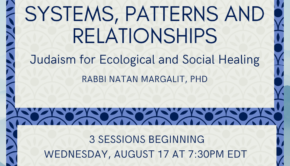Reading the Rabbis: Pesach and Song of Songs- Both Classes Combined!
Instructor: Rabbi Natan Margalit, PhD.
Dates: February 10, 17, 24; March 3, 10, 24, 31, April 7, 28; May 5, 2022 (10 classes)
Day and Time: Thursdays 7-8:30 p.m. Eastern Time Location: Zoom
Fee: $270
These classes are now underway, but it’s not too late to register!
Use the link below to register for both of Rabbi Natan’s classes at once! Learn more about “the Puzzle of Pesach” here, and learn more about “Song of Songs” here.
“Song of Songs in the Rabbinic and Mystic Imagination”:
In this class we will gain skills and practice in reading Midrash, Talmud as well as some Zohar and other mystical texts in the original languages (Hebrew and Aramaic). This class is for those who already have some Hebrew and wish to gain more skills including: some basic Aramaic vocabulary, used in the Zohar and in many rabbinic texts, reading without vowels, reading Rashi script, learning some common “roshei tevot” (acronyms, abbreviations) and how to put it all together into making sense of these fascinating texts. The Song of Songs is one of the most beautiful and also most inscrutable of all the biblical books. Its poetry and imagery inspired Rabbi Akiva to compare it to the Holy of Holies. No wonder it nourished the imagination of both the early rabbinic sages and the later kabbalists and mystics. Students will have an opportunity to develop their skills starting from where they are, using “hevruta” learning partners, as well as sharing and supporting one another in the (virtual) classroom setting.
“The Puzzle of Pesach”:
Have you wished that you could open the sources of the rabbinic tradition and read them for yourself? In this course we will not only learn a lot about the holiday of Passover, but we will gain skills and practice in reading Mishnah, Midrash, Talmud and commentaries in the original languages (Hebrew and Aramaic). This class is for those who already have some Hebrew and wish to gain more skills including: some basic Aramaic vocabulary, reading without vowels, reading Rashi script, learning some common “roshei tevot” (acronyms, abbreviations) and how to put it all together into making sense of these fascinating texts. We will dive into the Mishnah of Tractate Pesachim (chapter ten) with traditional commentaries as well as midrash and Talmud.
Students will have an opportunity to develop their skills starting from where they are, using “hevruta” learning partners, as well as sharing and supporting one another in the(virtual) classroom setting. In addition to the “nuts and bolts” of learning to read these texts, we will ask: “What are the best strategies for reading these texts?” “What are the rabbis trying to accomplish?” “What is left out of the text which the reader needs to infer?” and more. Students will get the most out of this course by using time outside of class to prepare the materials. This can be done with a study partner or, if they prefer, on their own. In this way, the class time can be used to learn new skills, get feedback, and of course, engage with the material through analyzing and discussing the texts of Mishnah, Midrash and Talmud.





